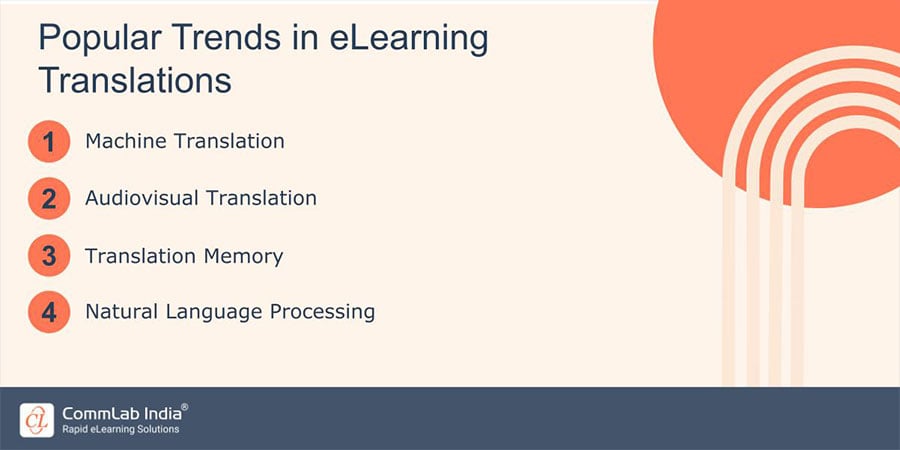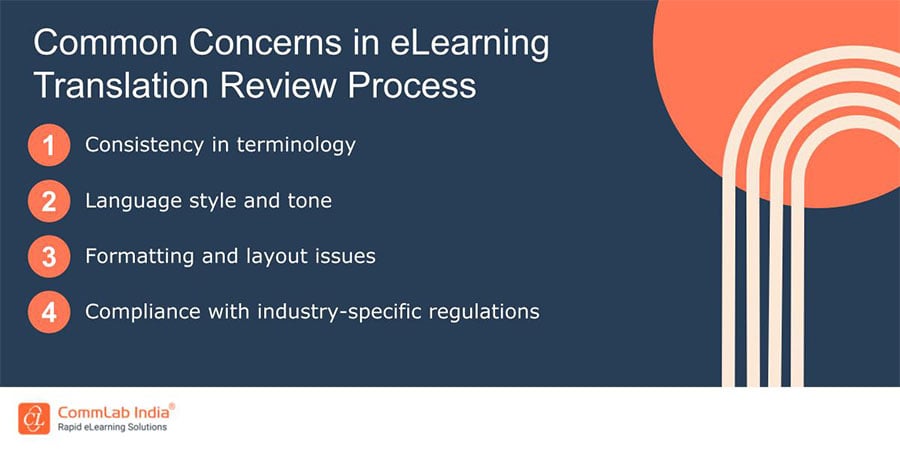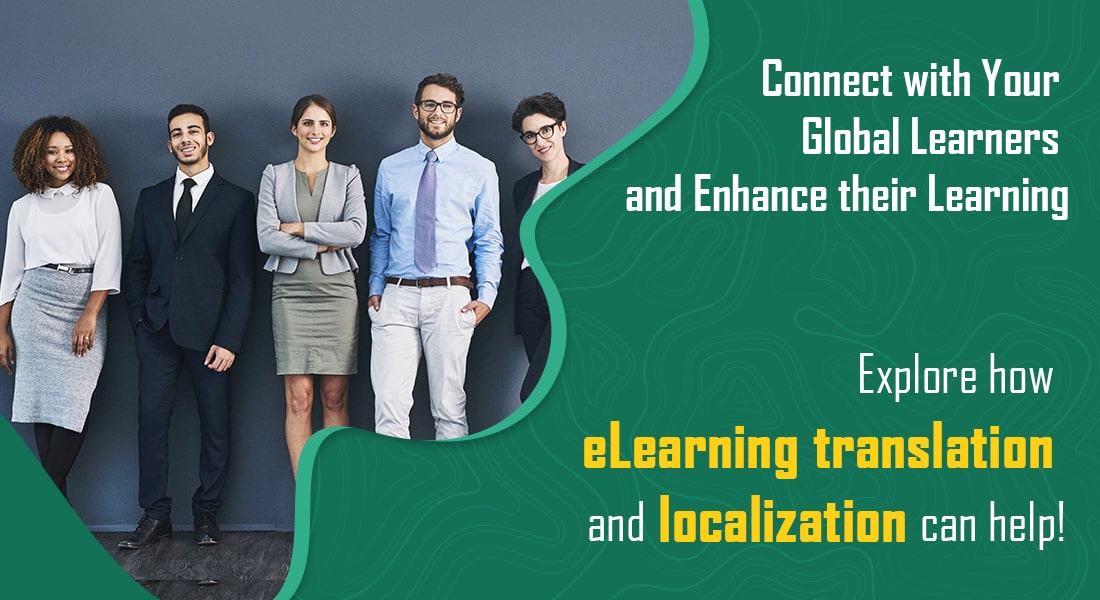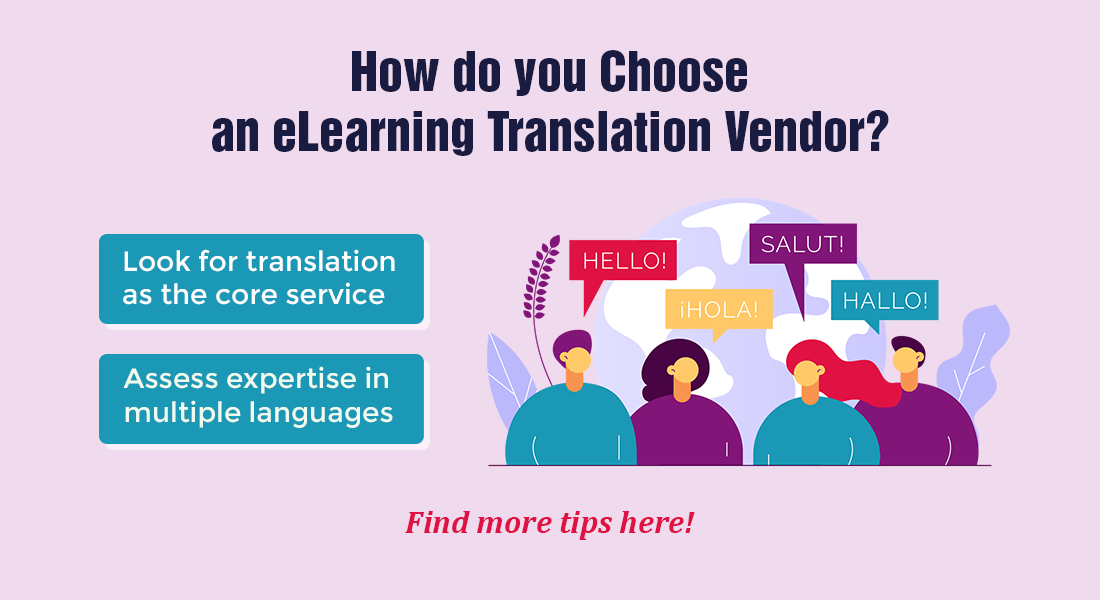Mastering Multilingual Training: The Must-Have Services of eLearning Translation Vendors
When choosing an eLearning translation vendor, it's important to consider the services they offer to ensure a smooth and effective process. Read on to explore a checklist of services that a vendor should ideally provide followed by a case study to help you understand our translation expertise.

Hey there! So, you’ve got this awesome eLearning content, right? Now, imagine how much cooler it would be if it were available in multiple languages. An ideal eLearning translation vendor offers comprehensive translation solutions to help you effectively translate your courses and deliver them seamlessly. An experienced team of translators specializes in accurately translating text, audio, and video components, ensuring that your content reaches a wider audience in their preferred language. No more lost-in-translation moments or puzzled learners! Let’s explore most of the major services and tasks a professional translation vendor needs to take care of.
Are You in Need of Professional eLearning Translation Services?
Here is a quick checklist to green tick while choosing one –
- Primary translation services
- Language expertise
- Project management and quality assurance
- Subject matter expertise and terminology management
- Review, feedback, and post-translation support
- Technology integration and security
Essential Services Offered by eLearning Translation Vendors
1. Primary Translation Services
The primary eLearning translation services usually include the accurate translation of the content from the source language to the target language(s). This consists of translating instructional text, dialogues, assessments, quizzes, and any other written content within the eLearning modules. In addition to text, the vendor should be capable of translating audio and video components of your eLearning content. This involves translating voice-over scripts, narration, dialogues, and subtitles to ensure that the content is accessible and comprehensible for learners in the target languages.
2. Language Expertise
The translation team should consist of linguists who are native speakers or have advanced proficiency in the target language(s). They should possess in-depth knowledge of the language’s grammar, vocabulary, idiomatic expressions, and cultural nuances to accurately convey the intended meaning of the content. They will adapt the content to make it culturally appropriate and relatable, ensuring that learners in the target languages can fully engage with the courses.
3. Project Management and Quality Assurance
Offering dedicated project managers who oversee the entire translation process, ensuring timely delivery, coordination, and quality control needs to be a green tick on your checklist. Quality assurance measures, including rigorous proofreading and editing, should be in place to maintain accuracy, consistency, and adherence to learning outcomes.
They should ensure that the translated content is appropriately formatted for the eLearning platform, including text layout, fonts, and alignment to maintain the original design and user experience. Conducting thorough testing of the translated eLearning modules to identify and rectify any bugs or issues that may arise during the various extensive translation processes.
→ Download eBook Now: eLearning Translations – 7 FAQs Answered!
4. Subject Matter Expertise and Terminology Management
Usually, a team of translators with expertise in eLearning and instructional design is capable of accurately translating specialized terminology and industry-specific content. Make sure the vendor has a robust terminology management process in place. This includes creating and maintaining a glossary of terms specific to your industry or subject matter to ensure consistency in translation. Consistent terminology is crucial for effective comprehension and a cohesive learning experience.
5. Review, Feedback, and Post-Translation Support
The vendor should have a mechanism in place to incorporate your reviews, feedback, and revisions. Make sure your vendor also provides ongoing support for any updates or revisions required after the initial translation, ensuring continuous improvement and accuracy of the eLearning content. They should be open to working collaboratively with you to refine the translations and address any concerns you may have, ensuring that the final output meets your requirements.
6. Technology Integration and Security
An eLearning translation vendor should utilize translation management systems (TMS), content management systems (CMS), and other relevant technologies to streamline the translation workflow, maintain consistency, and manage content updates efficiently. They also need to maintain strict confidentiality and data security measures to protect sensitive client information and intellectual property.
Additionally, they need to adhere to industry-specific standards, such as SCORM (Sharable Content Object Reference Model), to ensure compatibility and interoperability of the translated eLearning content with different learning management systems (LMS).
Streamlining Multilingual eLearning Translation: A Client Success Story
→ Introduction
In the dynamic world of energy services, our client stands as a global leader with a workforce exceeding 17,000 employees across 75 countries and 350 strategic locations. With a strong focus on integrating innovative technologies and advanced digitalization, the company delivers sustainable energy solutions that maximize value and return on investment. Guided by their mission to produce energy for today and tomorrow, they prioritize efficiency, operational optimization, and safety. Their strategic solutions empower energy operations with increased flexibility and responsibility while upholding environmental and economic sustainability.
→ Client Requirement
The client sought to translate 48 existing eLearning modules into four languages: Arabic, LA Spanish, Brazilian Portuguese, and Russian, with priority given to Arabic and LA Spanish. The courses would be delivered to us in five batches, and our task involved translating the English content and submitting the Alpha version directly without proofreading. Additionally, the client requested the use of AI voice narration, specifically Microsoft Speech Studio, for the translated modules.
→ The Solution
Since the client preferred the authoring tool Articulate Studio for the translated courses, we assigned five developers from our skilled production team who possessed experience and expertise in Articulate Studio. Each translated course was sent for review to the client’s language-specific reviewer. While translating courses into Portuguese and Spanish proved relatively swift, the task of developing Arabic courses in Articulate Studio posed a significant challenge due to the right-to-left orientation of Arabic script.
However, by following a systematic process and collaborating closely with the client, we successfully achieved a high-quality translation and development output after a few iterations. Recording the AI audio narration in Arabic without pronunciation errors was an additional challenge that we overcame through meticulous attention to detail.
→ Result
Undoubtedly, the project presented its fair share of complexity for our team. However, with the expertise and dedication of our immensely talented production team, we successfully delivered the desired quality within a two-month timeframe. The translated courses empowered the client to reach a multilingual audience, enabling efficient knowledge transfer and skill development across their global workforce. The collaboration exemplified the effectiveness of leveraging our extensive industry experience and technological prowess to overcome challenges and deliver exceptional results.
Wrapping Up!
In conclusion, when choosing an eLearning translation vendor, it is crucial to consider the range of services they offer. A comprehensive vendor should provide accurate translation services for text, audio, and video components of your eLearning content. Thus, by selecting a reputable eLearning translation vendor that offers these services, you can confidently embark on your journey of globalizing your eLearning content, reaching a wider audience, and providing a seamless learning experience in multiple languages. If you still have any questions about eLearning translations, you can refer to this free eBook and get all your doubts cleared.




